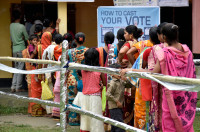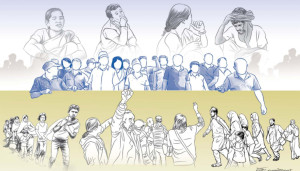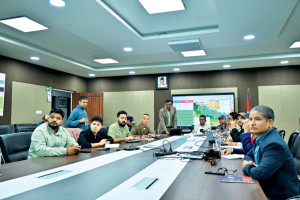Columns
Distributed leadership can resolve the prevailing problems in schools
Distributed leadership is guided by change-oriented intentionality: It requires formal leaders to create as many opportunities as possible for the staff..jpg&w=900&height=601)
Hari Singh KC
One cannot disagree that the traditional methods of educational leadership need to be discarded or updated to address the complex and multifaceted demands of the present day. So the question arises: What type of leadership would be appropriate to meet the educational goals of the present time and context? While some theorists advocate formal leadership that focuses on organisational structures, rules and regulations, like in the bureaucratic model, others argue for a more flexible and collaborative approach such as collegial and participative models. Researchers like James Spillane and Alma Harris put forward the idea of distributed leadership focusing on a shared vision, collaborative work culture and recognition of individual teachers' expertise.
The prioritisation of the formal model in educational institutions was primarily because of the influence of the industrial model practised in the era of industrialisation. The formal model emphasised the official, structural and hierarchical centralised system. However, it undermined the qualities, experience, contribution, and most importantly, the leading capacity of individuals working in an educational organisation.
Distributed leadership discarded the theory that authority resides solely with the principal and vice-principal. It stressed the interdependence between leaders, followers and their situation for enhancing students' educational experience. Educational leaders aim to bring into contact the diverse backgrounds, expertise and ideas of different people through collaborative activity. The principal exercises his or her leadership skills, not by imposing, but by influencing others in establishing a collaborative work culture, fostering participative decision-making, and motivating the staff towards better performance.
Distributed leadership is guided by change-oriented intentionality. It requires formal leaders to create as many opportunities as possible for the staff. By describing the leadership tasks along with the job description to a newly appointed teacher, the principal can formally distribute leadership. Likewise, he or she can utilise the expertise of a particular member of the faculty for a specific purpose. The principal can consult with the faculty member regarding the implementation of a newly introduced curriculum. The principal can also delegate more responsibilities to him or her. This will not only unlock the hidden potentials of the faculty member but also foster an 'allow-to-be-a-leader' culture in the organisation.
Formal leaders not only create opportunities and empower teachers but also involve them in the decision-making process. However, they have complete authority to implement or reject the decision made by them. In this way, formal leaders set limits in distributed leadership. It is particularly evident in matters such as financial, legal and human resource management. Therefore, formal leaders act as 'gatekeepers' in distributed leadership since they are the ones who create opportunities and set boundaries.
In the context of Nepal, private schools have mushroomed over recent years. There can be little doubt that most of these schools are guided by the philosophy of formal or hierarchical leadership. The official leaders in these schools are supposed to execute the rules and regulations that are usually pre-determined. Whether competing for the best result in the board examination or achieving a monetary target, these schools' practices have become more sophisticated, mechanised and stressful for the management team and teachers. Collaborative work practices, participative decision-making and motivation have been less prioritised. Teachers are involved in repeated mundane activities with few chances of providing innovative input in their work. As a result, the teaching profession has become one of the last choices of the people in the country.
The distributed leadership approach, if implemented correctly, can bring positive changes in the country's educational system. By creating teams and encouraging teachers to get involved in collaborative work, formal leaders will not only provide an opportunity for teachers to exercise their leadership skills but also develop a sense of ownership in them. For example, the principal can encourage the teachers of a particular subject to form a group and discuss teaching pedagogy, assignments, project work and evaluation systems, and come up with practical suggestions for enhancing teaching-learning practices.
The participating teachers will share their innovative thoughts and expertise with their colleagues. They will get a chance to lead the group at some point. While doing so, both seniors and newcomers will get an equal opportunity to explore their potentialities and leading capacity. Likewise, they will be self-motivated towards achieving better results. On top of that, the formal leaders will be able to adopt a fluid leadership approach which will be beneficial for the organisation in the long run.
Like every educational leadership theory, distributed leadership also has certain limitations. The effectiveness of the administration does not merely depend on a collaborative work culture and shared decision-making. The nature of the participants, context and leading capacity play an equally crucial role. Furthermore, distributed leadership is unlikely to produce a positive result if the goals of the organisation and teachers are not aligned. Also, there is always the risk of abuse of power when leadership is distributed to lower levels. However, if we overcome these challenges and barriers, distributed leadership can become an antidote to the prevailing problems in school leadership.
***
What do you think?
Dear reader, we’d like to hear from you. We regularly publish letters to the editor on contemporary issues or direct responses to something the Post has recently published. Please send your letters to [email protected] with "Letter to the Editor" in the subject line. Please include your name, location, and a contact address so one of our editors can reach out to you.




 19.12°C Kathmandu
19.12°C Kathmandu.jpg)















